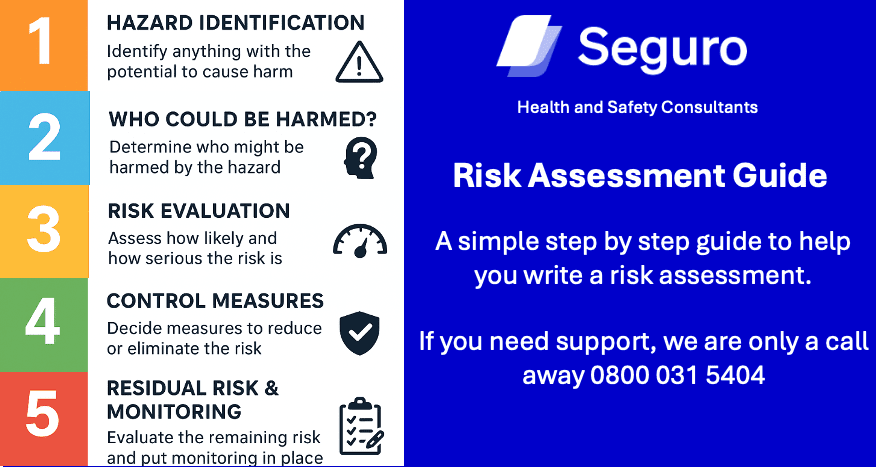What Is a Risk Assessment
What is a risk assessment? A clear, practical explanation for contractors, builders, and construction SMEs.
A construction risk assessment is a legal requirement under the Management of Health and Safety at Work Regulations 1999. It identifies the hazards associated with construction work, evaluates who may be harmed, how serious the risks are, and the control measures required to keep people safe.
In simple terms:
👉 A risk assessment explains what could go wrong — and how you will stop it from happening.
Risk assessments form the backbone of your wider RAMS (Risk Assessments & Method Statements) and ensure safe, compliant, and well-managed construction sites.
Why RAMS Matter in Construction
Construction is one of the highest-risk industries in the UK. Without structured RAMS, accidents become more likely — especially involving:
-
Working at height
-
Manual handling
-
Machinery and plant
-
Lifting operations
-
Excavations and groundworks
-
Noise, dust, vibration, and hazardous substances
A RAMS helps contractors:
✔ Reduce accidents and injuries
✔ Stay compliant with UK law
✔ Protect workers, clients, subcontractors & the public
✔ Avoid costly delays, fines, or enforcement
✔ Win more work (clients now ask for RAMS upfront)
Do You Legally Need a Construction Risk Assessment?
Yes — every construction business must carry out risk assessments, regardless of size.
And if you have 5 or more employees, you must write them down.
Even sole traders are responsible for completing RA for higher-risk tasks.
SHOP For Your Method and Risk Assessments Here
Who Should Carry Out a Risk Assessment and Method Statement?
RAMS must be completed by a competent person, meaning someone with:
-
Experience in the type of construction work
-
Knowledge of site hazards
-
Training in health & safety principles
Many small contractors use:
🔹 A health & safety advisor
🔹 A site manager or supervisor
🔹 An external consultant
Five Steps to Risk Assessment
There are five steps to a risk assessment. A strong, HSE-compliant risk assessment should cover the following:
1. Hazard Identification
Anything with the potential to cause harm, such as:
-
Working at height
-
Ladders
-
Electricity
-
Tools and equipment
-
Moving vehicles
-
Materials handling
-
Excavations
-
Hot works
2. Who Could Be Harmed?
For example:
-
Workers
-
Subcontractors
-
Visitors
-
Members of the public
-
Delivery drivers
-
Neighbours
3. Risk Evaluation (Severity + Likelihood)
This determines how dangerous the activity is and how urgently controls are needed.
4. Control Measures
This is where you state how risks will be reduced, such as:
-
Scaffold with guardrails
-
Machine guarding
-
Dust suppression
-
PPE
-
Training and supervision
-
Permit systems
-
Signage
5. Residual Risk & Monitoring
Even after controls, some risk remains — this must be evaluated and monitored.
Examples of Construction RAMS
Common types include:
-
Working at Height
-
Manual Handling
-
COSHH (cement, silica dust, adhesives, solvents)
-
Excavation & Groundworks
-
Use of Power Tools
-
Lifting Operations
-
Traffic Management
-
Noise & Vibration
-
Hot Works
-
Confined Spaces
These normally sit within your RAMS pack.
When Must a RAM Be Reviewed?
RAMS should be reviewed:
-
At the start of every project
-
If the work changes
-
After an accident or near-miss
-
If new equipment or materials are used
-
When site conditions change (weather, environment, layout)
A RAM is not a one-off document — it’s a living, working safety tool.
Risk Assessment vs Method Statement (RAMS)
Many contractors confuse the two, but the difference is simple:
-
Risk Assessment → identifies hazards & risks
-
Method Statement → explains how the work will be done safely
Together, they form your RAMS.
Benefits of Doing Proper Construction RAMS
For contractors and SMEs, the benefits go beyond compliance:
✔ Fewer accidents
✔ Stronger reputation with clients
✔ Better productivity
✔ Lower insurance claims
✔ A safer workforce
✔ Easier onboarding of subcontractors
✔ Higher-quality tenders and bids
Shop for your RAMS
It’s Quicker and more economical to buy RAMS that are written by professional health and safety experts. Some of our RAMS are twelve pages long and contain over 10,000 words. Save time and buy, they are only £10 each.
SHOP For Your Method and Risk Assessments Here
Conclusion: Construction RAMS Are Essential
A RAM is more than a form — it’s the foundation of a safe, compliant and efficient construction site. By identifying hazards, understanding the risks, and putting strong controls in place, you protect your workers, your business and your reputation. Learn the five steps to risk assessments and teach others.
Five Steps to Risk Assessment Infographic







